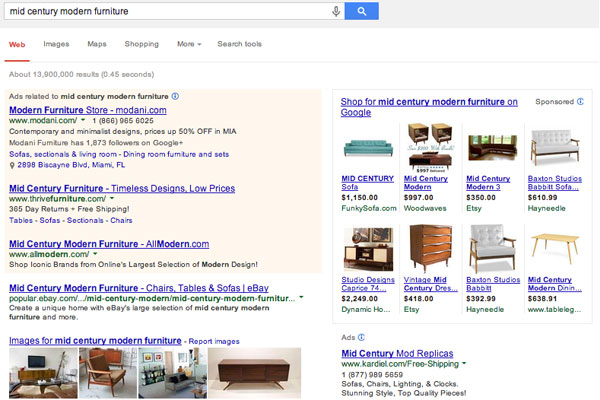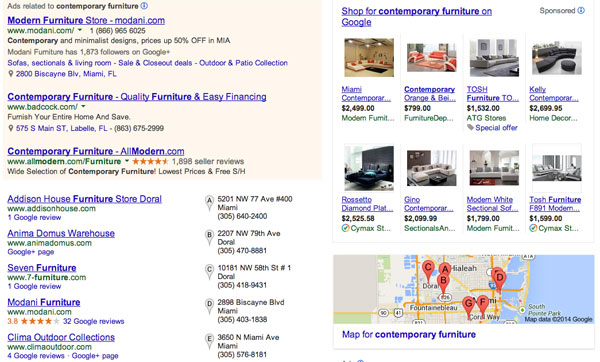
Years ago ranking on Page 1 of Google for competitive industry keywords was the “holy grail” of online marketing. However, as Google alters the appearance of search result pages organic listings are being pushed further down the page, making it more difficult to get noticed.
In the good old days of online marketing, SEO experts had minor obstacles to contend with with. Sure, PPC ads and local map listings were potential distractions from organic results; however, organic listings dominated Page 1 and were the crux of how most businesses (without big paid search budgets) generated leads online.
Over time, Google has introduced a variety of new content on search results pages, some which has taken over large chunks of real estate at the top of Page 1.
Let’s review two examples:
Example 1:
The below image shows Page 1 results for the search term “mid century modern furniture”. Notice that nearly all of the above-the-fold real estate is taken up by Product Listing and PPC ads. Just above the fold line there is a single organic search result (Ebay), immediately followed by a row of results from Google Images.
Example 2:
In this example we searched for “contemporary furniture”, which returned a blend of PPC and Product Listing Ads, as well as a 7-pack of Local Listings with a sidebar map. In this instance, you have to do some serious scrolling to locate the first organic result.
Just for kicks, let’s say you’re the owner of ‘1stdibs’, which is the 2nd organic search result from Example 1. Although you’ve achieved a pretty remarkable SERP listing and are outranking a retail giant like West Elm (3rd organic result), you’re now buried below fold and forced to complete for clicks with content that is mostly paid ads. Also, notice that 1stdibs does not appear in the PPC or Product Listing ads or Image results.
Even without having access to 1stdibs’ analytics data, it’s a safe bet that their organic search traffic has probably taken a hit. As search results become more visual in nature and Google allows the top-of-page real estate to be dominated by paid content, it will become increasingly harder for certain businesses (e.g. online retailers) to thrive on SEO alone.
How to create a new “holy grail”
To start, it’s important to realize you must play with the hand you’re dealt by Google. As they alter their algorithm and change the way results are presented to your potential customers, you must be open-minded and agile enough to make the necessary steps to remain visible in a competitive landscape.
Our first piece of advice is to optimize your website images to appear highly in Image search results. This SEO tactic is completely free and will give you the opportunity to gain exposure above the fold in the space Google has allocated for displaying the top image results for a given query.
Our second piece of advice (for businesses with a physical location) is to spend some time optimizing your Google Places listing to increase your chances of showing up in the 7-pack of local results. This is a critical component of achieving Local SEO results, which includes building citations on the most popular business listings websites.
Our last, and most ambitious, piece of advice is to research how much you can afford to spend on supplemental marketing techniques like PLAs and PPC. Showing up in multiple Page 1 listings will have a positive psychological effect on searchers, and will give you a better chance at calling attention to your brand.
In summary…
Focusing all of your online marketing efforts on organic SEO results is no longer enough to stay competitive. Google’s ever-changing algorithm is pushing organic listings further below the fold, which is forcing online marketers and business owners to come up with alternate methods to gaining high levels of exposure via the world’s top search engine.
Let`s Get
In Touch
Contact us today for a free consultation
and cost estimate for
your project.
We work with companies in all
industries, big or small.
Give Us a Call: 786-529-6039
Services
©2024 FUZE DIGITAL INC. Ignite Your Brand™ | privacy







